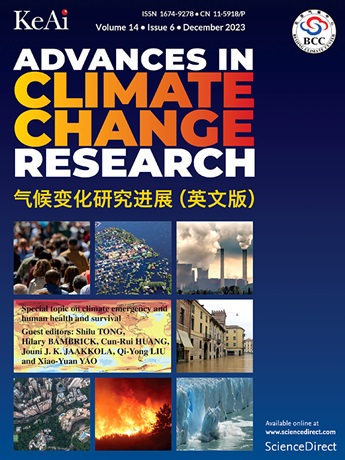Evaluation of the performance of WRF9km in simulating climate over the upper Yellow River Basin
IF 5.2
1区 地球科学
Q1 ENVIRONMENTAL SCIENCES
引用次数: 0
Abstract
Understanding the current climate in the Yellow River Basin is essential for accurately predicting future climate change and assessing its impacts on water resources and ecosystems; however, existing models exhibit notable biases in this region, primarily due to low resolution and errors in driving data and model domains. Using in-situ station observation data, CN05.1 gridded meteorological observation dataset, along with the ERA5 and MERRA2 reanalysis datasets, the performance of the WRF9km in simulating temperature and precipitation from 1980 to 2016 was comprehensively evaluated. Results indicate that the WRF9km model effectively captures the spatial pattern of air temperature, with a spatial correlation exceeding 0.86 (at the 95% confidence level) and a cold bias of −2.8 °C compared to CN05.1. This bias is primarily due to the underestimation of downward radiation and the overestimation of surface albedo. However, the WRF9km model fails to reproduce the observed warming trend across the entire region, especially during the summer. For precipitation, the WRF9km model generally reproduces the observed spatial pattern, with spatial correlation coefficients above 0.80 for all seasons except winter (at the 95% confidence level). However, the model overestimates precipitation relative to CN05.1 and underestimates it when compared to MERRA2. The precipitation bias is mainly attributed to the misrepresentation of wind fields and moisture by the WRF9km model. Regarding precipitation trends, different datasets yield divergent results, indicating substantial inter-annual variability that is difficult for the WRF9km to capture. Compared to the driving ERA5 data, the WRF9km model reduces cold biases between November and December, as well as wet biases across all seasons. The model also better simulates the winter warming trend in the western part of the UYRB and the summer wetting trend in the northern part. The evaluation of the WRF9km model provides valuable insights for the development of dynamical downscaling in terrain complex regions, especially for improving the surface albedo scheme and input driving data.
WRF9km模拟黄河上游气候的性能评价
了解黄河流域当前气候变化对准确预测未来气候变化、评估其对水资源和生态系统的影响至关重要;然而,现有的模型在这一区域表现出明显的偏差,主要是由于驾驶数据和模型域的低分辨率和错误。利用站内观测资料、CN05.1格网气象观测数据集以及ERA5和MERRA2再分析数据集,对WRF9km模拟1980 - 2016年气温和降水的性能进行了综合评价。结果表明,WRF9km模式有效捕获了气温的空间格局,空间相关系数超过0.86(95%置信水平),与CN05.1相比,冷偏差为−2.8°C。这种偏差主要是由于对向下辐射的低估和对地表反照率的高估。然而,WRF9km模式无法重现整个地区观测到的变暖趋势,特别是在夏季。对于降水,WRF9km模式总体上再现了观测到的空间格局,除冬季外,其余季节的空间相关系数均在0.80以上(95%置信水平)。然而,该模式相对于CN05.1高估了降水,而相对于MERRA2低估了降水。降水偏倚的主要原因是WRF9km模式对风场和湿度的误报。关于降水趋势,不同的数据集产生不同的结果,表明WRF9km难以捕捉到大量的年际变化。与ERA5数据相比,wrf9公里模型减少了11月至12月之间的寒冷偏倚,以及所有季节的潮湿偏倚。该模式较好地模拟了西部冬季增暖趋势和北部夏季湿润趋势。WRF9km模式的评价为地形复杂地区动态降尺度的发展,特别是对地表反照率方案和输入驱动数据的改进提供了有价值的见解。
本文章由计算机程序翻译,如有差异,请以英文原文为准。
求助全文
约1分钟内获得全文
求助全文
来源期刊

Advances in Climate Change Research
Earth and Planetary Sciences-Atmospheric Science
CiteScore
9.80
自引率
4.10%
发文量
424
审稿时长
107 days
期刊介绍:
Advances in Climate Change Research publishes scientific research and analyses on climate change and the interactions of climate change with society. This journal encompasses basic science and economic, social, and policy research, including studies on mitigation and adaptation to climate change.
Advances in Climate Change Research attempts to promote research in climate change and provide an impetus for the application of research achievements in numerous aspects, such as socioeconomic sustainable development, responses to the adaptation and mitigation of climate change, diplomatic negotiations of climate and environment policies, and the protection and exploitation of natural resources.
 求助内容:
求助内容: 应助结果提醒方式:
应助结果提醒方式:


